Fungal acne has been the cool kid in the skin care community for a while now. And it’s because almost everyone can relate in one way or another. People find it comforting that maybe – just maybe – their stubborn, recurring pimples that resist treatment aren’t acne, but a different beast entirely.
Though I enjoy testing out new products for fun, I generally don’t care much for gimmicky skin care trends and bandwagons: I’m not an easy target of marketing jargon, and I don’t like to do things just because everyone else is. In fact, I’m probably the least-easily peer-pressured person you’ll ever meet. So my initial thoughts hearing about something apparently everyone had now called “fungal acne” were, to sum it up, “Sure, Jan“.
I was being negative. My opinion was that most of these people were just desperate. After all, I couldn’t personally find many good quality photos of what severe fungal acne really looked like, so I assumed people were projecting and making assumptions. They would probably spend some time flirting with the idea, maybe trying a few treatments, then they’d go back to conventional acne products, making this just another learning step along the way to reaching their skin care goals. Good for them.
I tried my best to ignore the growing buzz around the topic because, well, I thought that getting invested would get my hopes up and have them dashed. I felt deep down that my skin was unsalvageable.
That was because, for the better part of my life, I’ve struggled with shocking skin. Not your typical ‘bad teenage skin’ either, but really awful stuff. It caused me so much emotional pain: both in cruel comments and my own negative self-worth. I’ve literally had a child ask me if I had chickenpox – yikes.
Even as I grew into skin care and found a good routine earlier than most and my skin improved, I’ve never had ‘good’ skin. My texture was never ever smooth, always slightly irritated and bumpy looking. No amount of makeup could cover it. It would drive me insane when friends said they couldn’t notice it, or my skin was fine (to try to make me feel better), but I’d do their makeup and feel the softness of their skin and compare it to mine, and I knew that something was wrong.
Even at its best and with perfect treatment, my skin would regularly relapse for seemingly no reason. Over time, I accepted that as my new normal.
But then the worst flare-ups I’ve ever had came, and I realised that I was dealing with something that had to be more than just run-of-the-mill breakouts.
Stubborn me still thought “there’s no way this fungal acne be real – these treatments can’t help me… right?“.
But thank goodness I eventually got down off my high horse – because I found that fungi HAVE been the cause of my severe ‘acne’, and I finally took the steps to be rid of it.
Here are all the juicy details: how my skin looked during the worst fungal infection of my life – from pre-breakout to the aftermath – and the cream that led to the prescription that’s kept me fungal acne free for two years.
What a fungal flare-up looks and feels like
Warning: Let’s hope you’re morbidly curious – this is yet another post that includes some super graphic, unflattering, real photos of my skin. You’re not looking at a filter or my good angles – this is the real deal and it’s ugly! Also, please excuse the many lip/nostril close-ups I’m about to expose you to.
The beginning stages and warning signs of an infection
The worst of the attacks came in waves.
Every cycle of these flare-ups would start the same – on an otherwise fine skin day, the absolutely tiniest of whiteheads would appear.
Maybe it was one or two, or up to ten, but they were pinprick sized and grouped together. I could easily scratch them off with a finger, leaving behind only a tiny red mark.
It was barely enough to take notice of. When you’ve suffered from terrible skin your whole life, you’d look at these and think “pfft, so what?”. And so would I.
The spread and worsening
Then, the next morning I’d wake up and my skin would feel rough. Really strange, like I’d got a layer of Elmer’s glue on and I just wanted to rub it off. It feels grainy and dry. When I looked in the mirror, my heart sank. I could see hundreds of teeny tiny inflamed whiteheads.
They might not look like much now, but by this stage after 6 separate episodes, I knew what was about to come – and I couldn’t do anything to stop it.
The worst of the infection and hitting rock bottom
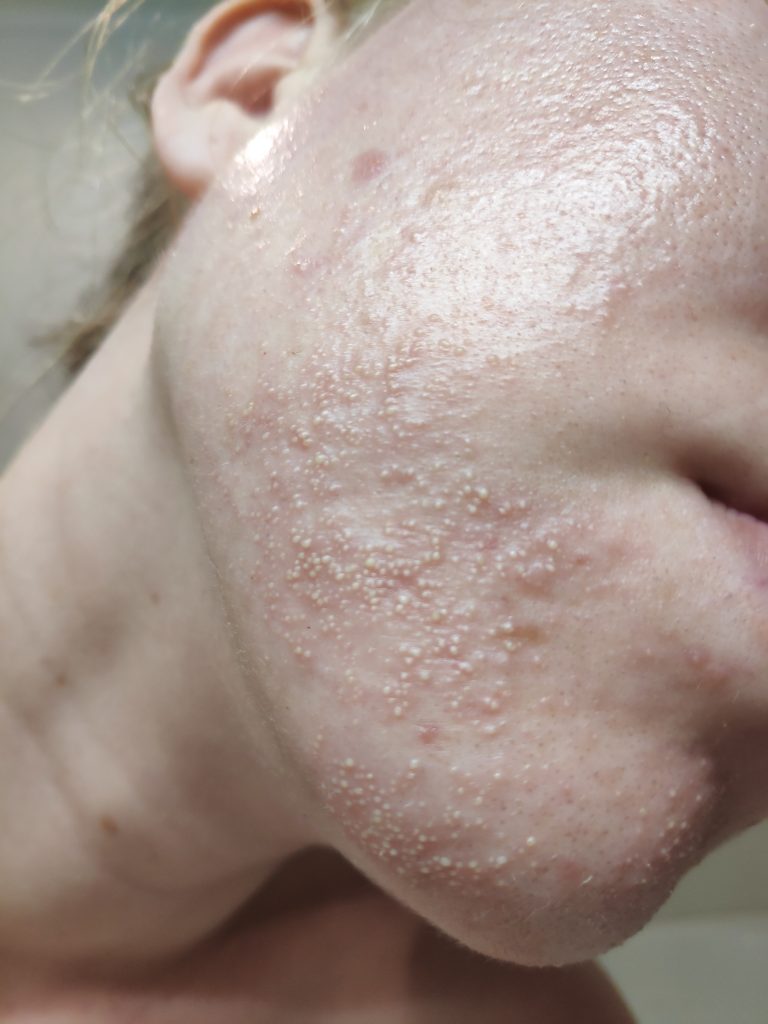
Thousands upon thousands of blisters sprouted and spread like wildfire.
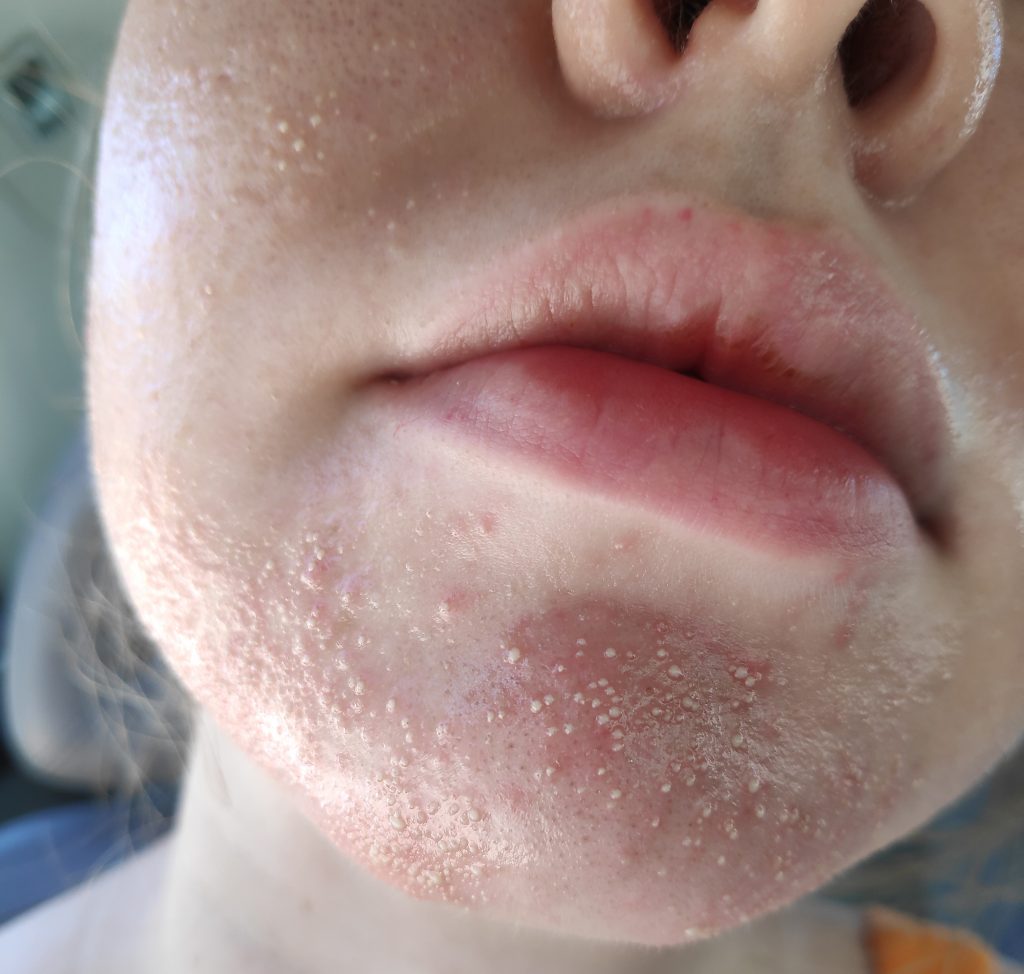
They started and would be worst on my chin. They felt very rigid, and if I picked at them, they would pop dramatically and painfully, spitting out a small amount of firm pus (yuck) and leave behind an oozing red mark.
Picking at it would only make it spread faster, though. They traveled up my cheeks and even onto my forehead. They were so unbelievably itchy and painful.
The texture is appalling. Under strong lighting, you can see the deep swelling and damage being done to my skin.
No traditional acne treatments I’d put on my skin would touch it. It was just a matter of waiting it out.
If I had to guess, I’d say the amount of uninvited comments about how to fix my “acne” from near strangers at this point tripled. And believe it or not, my ever-loyal friends and coworkers would still try to convince me that it was barely noticeable, bless their hearts.
When I had to go to a highly important job interview looking like this, and it tanked my self-esteem, not to mention being a huge eyesore and undoubtedly a negative factor. Nobody wants to be known as the candidate that had the distractingly awful skin.
The aftermath and healing from an outbreak
Around 3-5 days from the initial outbreak, slow and painful healing began. New whiteheads stopped appearing and old ones dried up into a crusty, sore layer. The texture slowly began to flatter and small areas of skin returned to a more normal colour.
I would be left with highly vulnerable post-inflammatory erythema and some hyperpigmentation that took weeks if not months to clear. For someone like me who has struggled with a compulsive skin picking disorder, this can wreck my relationship with my skin and bring me right back down again.
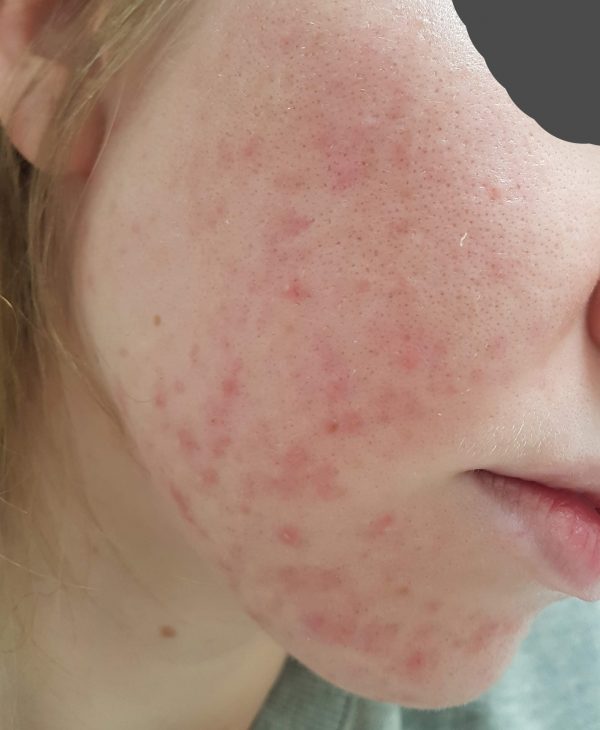
… and repeat
The worst part about all of this? Just weeks or even days later, the first few tiny bumps crop up and I know I’m in for it all over again. I would never fully heal, and even my best days were bumpy and red.
At this point, I still didn’t understand what was causing these extreme breakouts unlike any I’d seen on other people.
It’s absolutely draining mentally to know that your skin is about to go through a horrendous experience, and not to be able to do anything to stop it and having no idea WHY it’s happening.
The symptoms that made me suspect I had a fungal infection
Fungal infections look and act differently between people, depending on the location, fungi, and just your body’s reaction, so it can be tricky to spot. If it’s not on your mind, you might not recognise the signs.
For me personally, the tip-offs were:
- There were sudden periods of my acne becoming distinctly worse and more widespread than seemed normal (as you’ve just seen photo evidence of).
- I had a red, bumpy skin texture even between my pimples and even on a good day.
- My lips, especially around the edges, would feel thick like they have a layer of dead skin, and itch all day.
- Sometimes my chest would break out in red dots, most often after exercising.
- No amount of anti-acne treatment would touch the endless deep, sore pimples and the tiny whiteheads!
- My skin surprisingly got worse after taking a course of antibiotics.
- I had had a fungal skin infection (seborrhoeic dermatitis) before.
The solution that finally began clearing my fungal folliculitis
After trying every other avenue, and unable to stand the itch and frustration, I gave what seemed like a crazy idea a try.
I applied topical antifungal cream on my face – and it worked.
That’s right – I really used a Clotrimazole cream (specifically Canesten) designed for athletes foot, ringworm, thrush (ew) etc. and popped it on twice a day in place of moisturiser.
Just bit by bit, my skin looked less angry. Not perfect, but much improved.
I waited it out until I had one more bad flare up a couple of weeks later that the cream didn’t touch. That finally pushed me over the end and I rushed to a doctor during the worst of it, who took one look at my skin and started listening to me and taking me seriously.
What the doctor prescribed: Fluconazole 50mg oral capsules
I told my GP everything: about all my symptoms, showing her my photos and logs, and speaking about taking antibiotics in the past that made it worse, and the minor success of the antifungal cream. I’m so grateful for her open mind and willingness to listen. She and I together decided to give oral antifungals a try. Specifically, Fluconazole 50mg capsules taken once a day for two weeks.
Within days, my skin looked already better than it had pretty much ever looked since I was 13.
Not just ‘good’ – or what I used to think was good – but amazing. Radiant. Smooth and calm. I literally cried.
All the pain and stress and failed acne treatments fixed with a simple doctor’s visit.
I wish it was easier and that there was a way to cure it at home. While I think prevention and minor treatment can be done at home with a certain routine, for a severe, recurring case like mine, the best thing I did was to move on from at-home treatments to seeing a doctor. I’m sure that my meticulous documentation of the progress of the flare-ups – in notes and photos on my phone – helped the doctor understand the issue to diagnose it properly.
What is fungal folliculitis/fungal acne?
To understand that, you first have to know that our skin is covered in tiny organisms. Think bacteria, mites and yes – fungi. That’s totally normal. What’s not normal is any one of these taking over and over-populating the skin. At high levels, anything will begin to cause issues.
The fungi that live on our skin
A huge number of fungi grow in the world and on our skin – without us even noticing! They include:
- Candida
- Malassezia
- Epidermophyton
- Microsporum
- Trichophyton
- Aspergillus
- Saccharomyces
…and hundreds more!
Causes of fungal overgrowth
Everything that makes up our skin flora lives in harmony. A wide range of organisms – from bacteria to even mites – share the surface, feeding on our skin cells and oils, and usually causing few problems.
Fungal infections where the numbers grow too large can happen for a few reasons:
- Eradication of other organisms like bacteria, such as when you take antibiotics, can give fungi the room to become too strong and overtake the natural balance.
- Imbalanced hormones or a predisposition to certain skin types and conditions like extreme oiliness, low cell turnover, and eczema can feed fungal overgrowth or allow infections to take hold quickly in broken skin.
- Finally, lifestyle choices such as hygiene habits, activities like sports, and even certain environments just lend themselves well to fungi. Think of being hot, sweaty and humid. Anything that creates excess heat, oil, or moisture – especially if it’s not washed off quickly – can promote fungal overgrowth.
Why is fungal folliculitis so hard to treat?
Fungal folliculitis actually commonly referred to as pseudo-acne. Many teens develop the condition and don’t respond to traditional acne treatment and kind of just get… left behind. Because acne is so common, many doctors don’t take the time to consider it could be something else.
Also, oral antifungals can be hard on organs of the body so many medical practitioners are reluctant to prescribe them without proven attempts at a traditional antibacterial acne regimen.
There’s a general lack of awareness around fungal acne, so it’s important to educate yourself, keep track of what treatments you’ve tried and what you’ve not, and be an advocate for trying something new if you think it might be what’s plaguing you.
Photos of my skin after the course of antifungals
Here’s what you’ve all been waiting for – here’s how my skin looked one month after starting my course of antifungals.
You can still see some inflammation from the healing but it’s night and day compared to what I was dealing with before. My other products had a chance to work, I could treat regular bacterial acne without fear of sending the fungal infection into overdrive, and mostly I could finally relax again.
Photos of my skin now: two years fungal acne free
And now, in 2020, my skin still isn’t perfect – and will probably never be, partially thanks to the high-quality camera lens I now see it through – but just LOOK at the difference as compared to at its fungal-acne worst!
A fungal acne friendly skin care routine?
Believe it or not, I still don’t follow a “special” routine to keep my fungal acne at bay. After the course of antifungals, I’ve not had any problems like that ever again. I think once you’re at the point that I was, a doctor is the only person who can help you get back on your feet. Now when I spot a few little suspicious whiteheads or red dots on my chest, a few days of clotrimazole cream and giving my skin a break from any of my oil-based products is enough to get rid of it again.
In addition to those, I make sure to always shower straight after exercising, dry off thoroughly, and wash my towels and sheets extremely often. Also, after a traumatic toenail injury in late 2018, I contracted a fungal infection of the toenail, which is a whole beast in and of itself. While I’m still treating it to this day, I’m very cautious not to cross-contaminate by touching my feet then any other part of my body without washing my hands.
I have to thank F.C. over at Simple Skincare Science blog. He has made the famous Malassezia Folliculitis post that I referenced many times during my research. It’s one of the most informative posts I can recommend to you all. There’s fascinating explanations of the science behind why we get fungal acne, what products feed it and what products prevent it. If you’re struggling with recurring infection, and looking to build a foolproof anti-fungal routine to remove any possible trigger ingredients, that’s the place to go.
Final word
This post isn’t to congratulate myself, to convince you to go on medication, or to say that every case of stubborn acne is fungal – but rather to say that an open mind is always the best way to solve any problem. You might end up like me, and find a solution you never even thought possible.
I’ve come to terms with the fact that fungal acne could be something I just manage and keep a wary eye on for the rest of my life – but that’s ok. I can’t wait to see where I go from here without fungal flare-ups as bad as that ever holding me back. I’ve developed an awesome skin care routine and strategies to rely on to keep me motivated and on track. I hope you find a solution that helps you love your skin as well!
If you’re in need of guidance to take better care of your skin, or you’re curious to see more of the habits that got me to where I am now, I’ve compiled them all into an 80-page guide for the skin care beginner. The Strategic Skin Program means you can all follow the same steps as me at home! I’ve included tons of advice, quizzes, motivation, myth-busting and so much more – so check it out!

















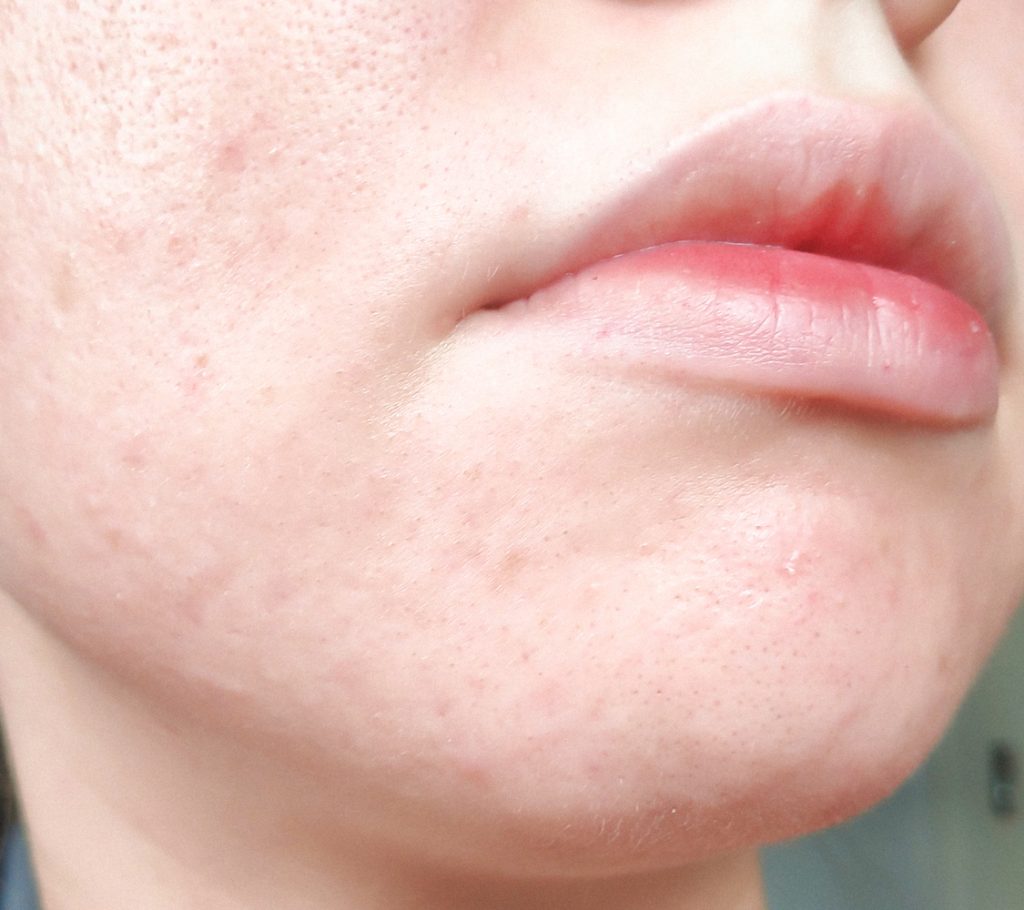
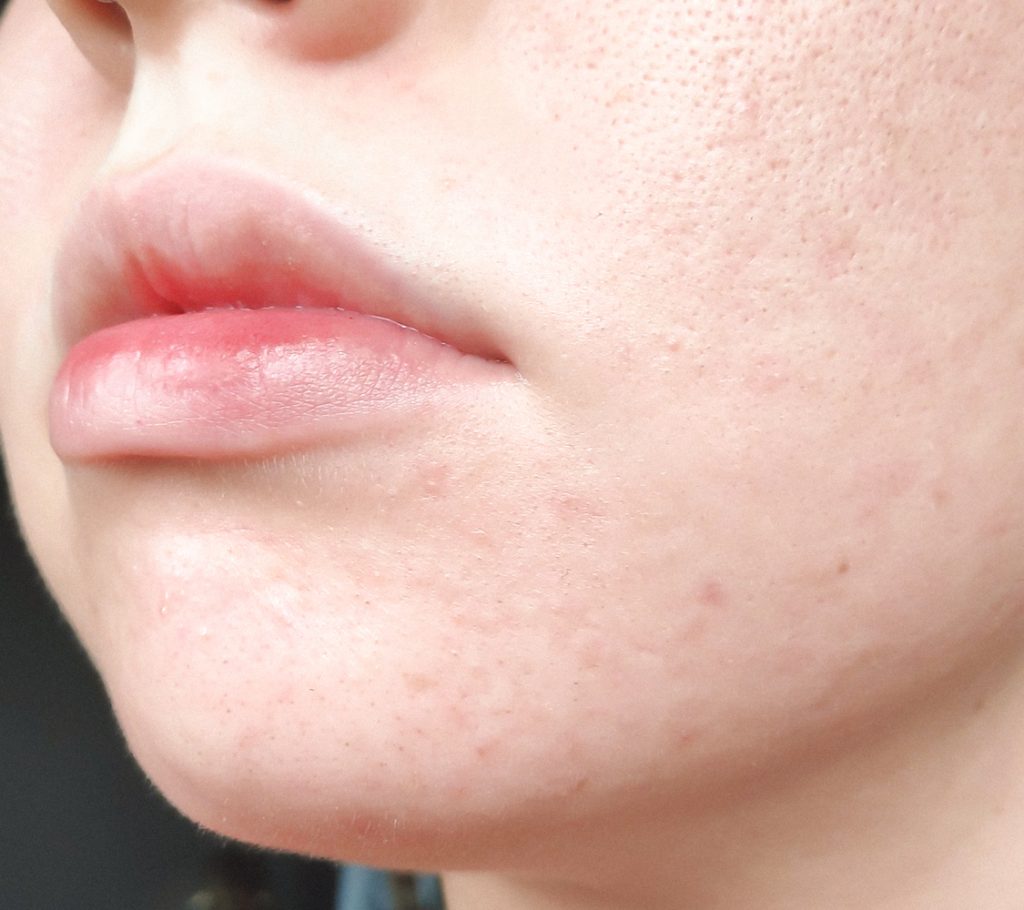
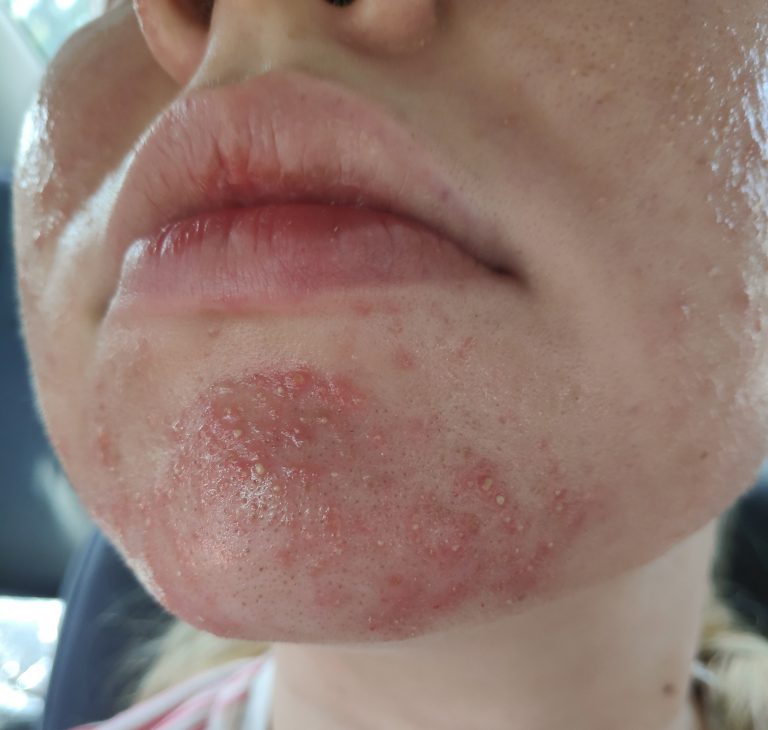
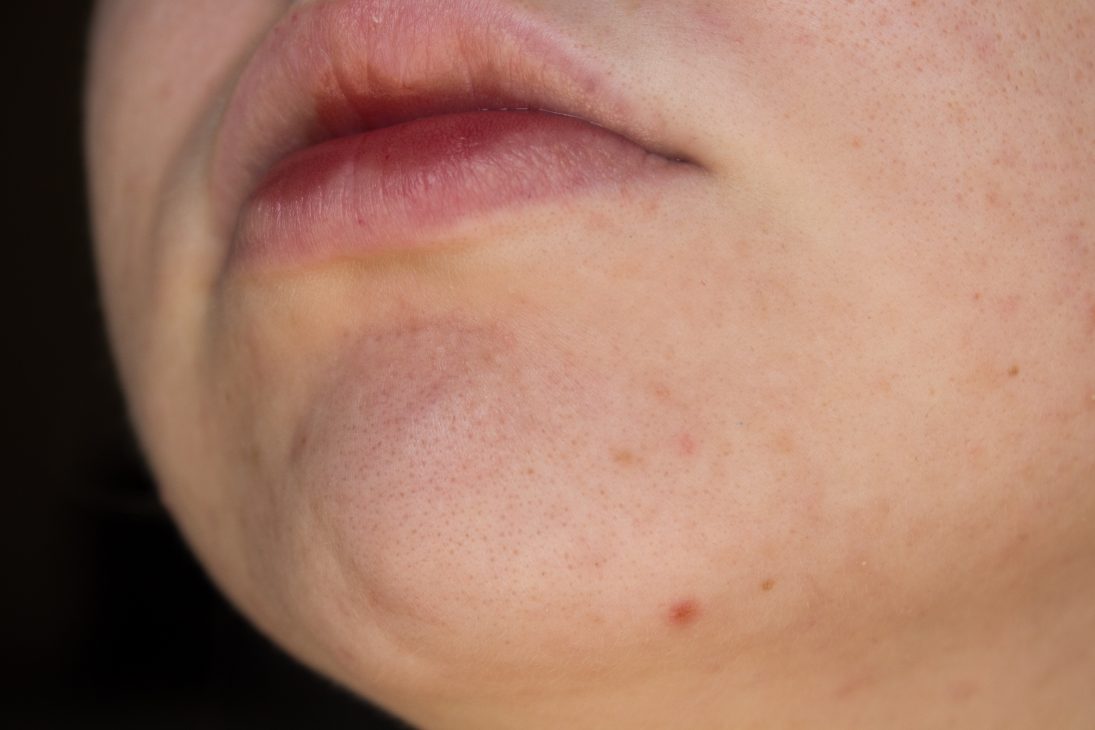
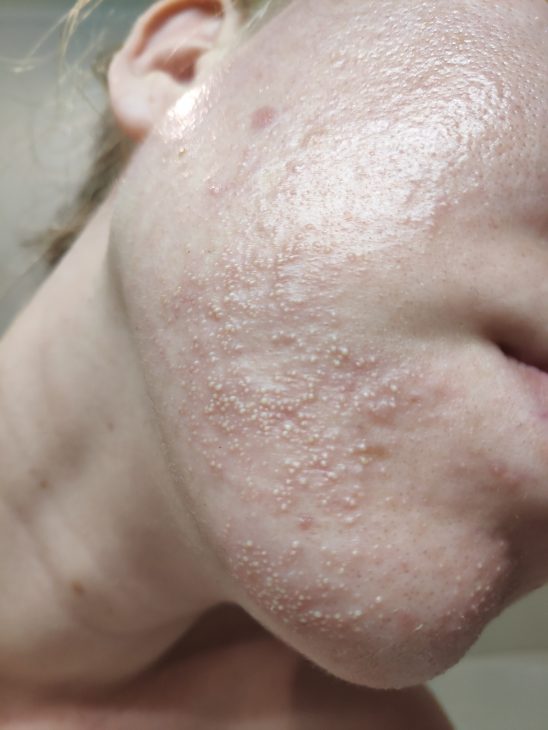
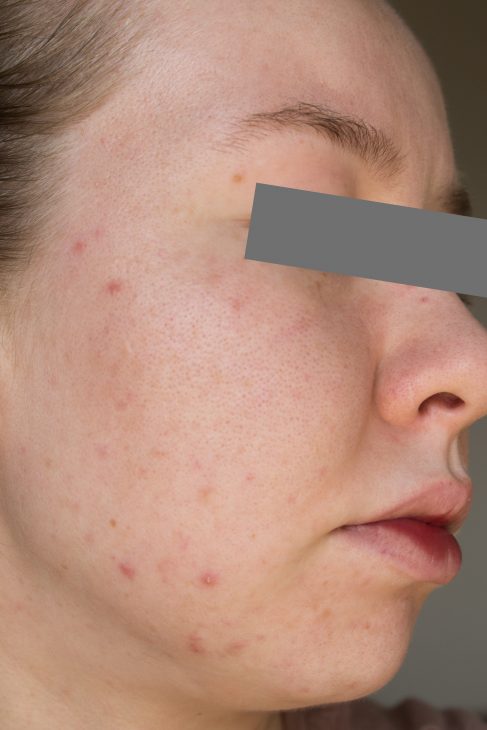
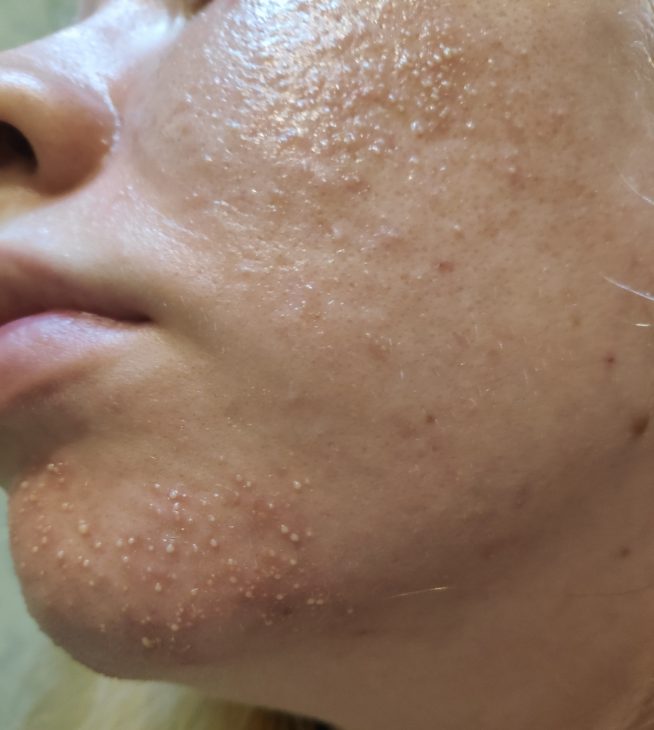
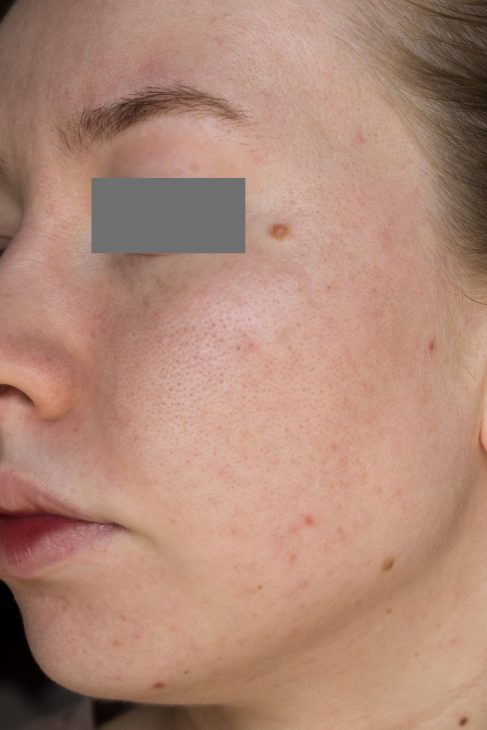

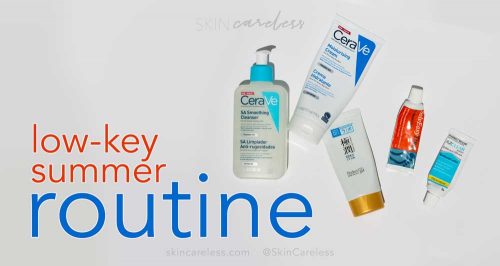
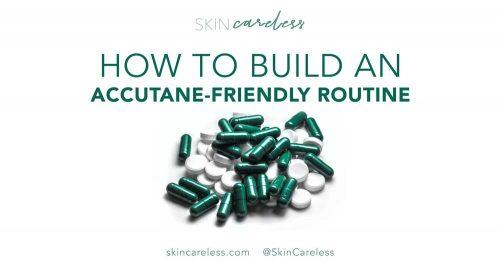

Did you use Fluconazole? Make sure you get your gut checked. My skin was wonderful after orals but once I slipped back into drinking alcohol, eating gluten and stress it comes back. I usually have to do a few days of laxatives and drink a ton of water and no sugar to get it to go back down. Be careful!!
Yes it was! I’ve done a gluten elimination diet in the past for another issue and unfortunately it wasn’t for me and I saw no improvement in my skin. I’ll definitely keep an eye on my gut health though!
What dosage of fluconazole did you use and for how long? thanks!
Hey! I was prescribed 50mg a day for 14 days 🙂
Wow! So happy for you. How is your skin today? Do you still have fungal acne?
Hey! No, today I am totally fungal acne free yay! My skin’s looking better than ever. Thank you 🙂
Hi, after your 2 week course did you ever take the fluconazole again? And have you had any flare ups
I did have a minor flare up and took another week’s worth about a month into the treatment. Since then I’ve had no more issues!
I’m so happy my doctor just prescribed me fluconazole 50mg for 4 weeks! Shall I do what u did and take it for 2 weeks and then keep the rest in case I have a flare up?
Hello! I’m currently going though the same problem. after taking the medication are you still doing the same fungal safe skin care routine ? Did it cure the infection 100%? have you had any flare ups ?
Hey! I am no longer taking this medication, and I’m doing a variation on my ‘Winter 2018’ routine and still having fantastic success! It seems to me that my fungal acne days are behind me, there’ve been essentially no flare ups since my last update. Yay!
Hello! May I ask if I can buy that in pharmacy without the prescribed of dermatologist?
Hello! In my country (Australia) you must have a doctor’s prescription to purchase antifungals.
Hey! I also suffer from fungal acne. I’ve spent a lot of products already. Last last last month i just cleared up my fungal acne with simple fa routine but now it came back and i’m starting to give up :(( do you need to visit the doctor for the fluconazole? Or i can buy at any pharmacy?
Hi – I recommend visiting a doctor (as you must to get a prescription) and if the antifungals don’t work, move onto other anti-acne approaches as it may not be the cause after all! Good luck!
After treating your fungal acne, did you still have to deal with your dehydrated skin? And if you did how did you do it?
Yes, the dehydration was a separate issue but they each exacerbated the other. Check out my post about dehydration here for tips. I hope it helps!
Your post has given me the reassurance and confidence that I can get this under control. I have a months supply of fluconazole sat on my desk and I’m praying I have the success you had. Thanks for sharing your experience x
Best of luck, here’s wishing you a speedy improvement!
did you have any success?
[…] a year of using this product only 1-3 times a week (aside from a period of time where I was suffering from fungal acne), I’m hooked. I find that the best way to describe it is that iit gives my skin a more […]
Hello, for how long did you have Malassezia?
[…] The less common but equally stubborn fungal “acne” appears as many small, skin coloured bumps, often found on the forehead and cheeks. They can sometimes be itchy. It doesn’t cause cystic pimples and won’t respond to traditional acne treatments at all. I personally went through a super rough patch with fungal acne and have documented my experience and…. […]
[…] over and proper treatment of other comorbid or acne-like infections such as fungal folliculitis, allergies, eczema, rosacea, etc. will make your skin as healthy as it can be to fight off the […]
Wow! What an informative, well-researched and documented testimonial! So extremely helpful– I just called my doc and made an appointment. Thank you!
Thank you Kelley! Best of luck and I hope you and your doctor find something to help 🙂
My primary nurse prescribed me 200mg of fluconazole about 3 months ago. (She did research on how to treat it because she’d never treated it before or even heard of it before I’d mentioned it). I took one pill once a day for 26 days… my “fungal acne” decreased in size by about 85-90% within 2-3 days and remained that way. My nurse was amazed at how effective the fluconazole was, but I was confused why it didn’t seem to completely go away. About 4 days after I stopped taking the medication, I had one day where no new fungal acne spots appeared. However, after that day, my fungal acne started increasing in size again. My nurse also said to take fluconazole once a month after I stopped doing them once a day (which was supposed to be when I stopped getting new spots, but that didn’t seem like it would happen). So, I took another pill 2 weeks later after stopping taking them once a day (because I was worried my fungal acne was going to completely return full-force). My fungal acne, again, stopped appearing as much, but started picking up the speed sooner or later. A month after that pill, I took the next pill. And, I think, for the first time I stopped seeing any new spots for 7 full days. But then they started reappearing again and are picking up the speed… so I’m not sure what to do. I only have 2 pills left.
[…] part of this story is that last year I went through from the worst skin of my entire life. I suffered from a recurring fungal infection for several months. I could never tell what was causing it, and to this day I didn’t know. I’ll include a […]
Hi! Maybe I’m going through the same. I am not sure whether or not I have fungal acne because I havent take the time to see a doctor. I got red bumps on my cheeks and they feel super itchy. I feel like having ants crawling all over my cheeks. Could you tell if I got it or not? My skin is also dehydrated so I wonder if using mosturizer makes it worse.
Hey! It’s hard to say without seeing your skin, and I’m not a medical professional. I’d suggest cutting out everything non-essential from your routine and trying some standard acne treatments like benzoyl peroxide or salicylic acid, and if you see no improvement at all within 1-2 weeks, try a topical antifungal cream. If that helps at all, head to a doctor or dermatologist and tell them your experience and ask for an antifungal prescription. After you’re sure it’s fungal and hopefully it’s all cleared up, you can start adding back in all your original products and see if anything causes it to flare up for you personally. Good luck!
Omg after I used a Clotrimazole cream, it stopped feeling itchy right away. Thank you a lot! Can I use it everyday for long term?
This was a highly informative post and I am glad to see you have recovered! Due to lack of insurance and being blown off by several doctors, I recently bought a microscope/fungal stain and diagnosed myself with tinea capitis (ringworm of the scalp). Though I have discharge from the follicles it’s mostly non-inflammatory, hence repeated misdiagnosis. I am a stickler for the details so I feel the need to point out that both microsporum and Trichophyton fungal species are not part of our normal floral. They are “ringworm” species and feed on healthy keratin. Though some people can be carriers, it’s highly contagious! If left untreated they eventually destroy the follicle completely and hair will no longer grow. When on the scalp, trich eats the hair from the inside out (the one I am treating) and microsporum eat from the cuticle. My hair became so damaged I’ve had to shave it twice in the last 6 months.
Hey there – how interesting, thank you for sharing! Fungal infections are so little understood and it’s difficult to get rock solid information about them. Good luck on your recovery too!
Hi Essie,
Been struggling with fungal acne for quite some time now. I’m not sure exactly if its fungal acne, but I wanted to try the clotrimazole before going to a naturopath or dermatologist again. How long did it take for you to see results after using the clotrimazole? Also, have you heard of Dr. Eddy’s Happy Cappy Medicated Shampoo?
Hi there,
The clotrimazole took the edge off the intensity of the folliculitis pretty quickly, within a couple days it looked better – but not cured. Oftentimes folliculitis is deep down in the pores where topical products just struggle to reach, and require courses of medication. I did try medicated shampoos at one point but unfortunately the surfactants were just too much for my skin and dried it out!
hi there, after read this the other week and decided to try the antifungal cream (thrush cream) on my 18 year old daughters face who has suffered from bad acne for quite a few years now and has been on doxycycline for ages which has done nothing to clear up her skin, her skin is now so sensitive and dry….last week she put on the antifungal cream and omg what a difference still had acne but not as aggressive just look so much better , so then went to GP to get script for fluconazole but he gave her 150mg once a week for 4 weeks does this seem like the right dose as he really had no idea, i notice she also has a dry scalp quite flaky..she users hemp seed oil on her face and she is celiac and cant have dairy..do you think shes on the correct dose and fluconazole can be brought otc in australia, thank you
Hi! So glad to hear your daughter is showing positive results with fungal treatment. Unfortunately, I can’t say what dosage is appropriate, though once per week does not seem like a lot. I’d recommend sticking with the prescription, and once the course is complete returning to the doctor with her results and potentially going in for a second stronger round only if necessary. As far as I know, fluconazole is not available OTC in Australia due to potential stress it can place on organs like the liver if taken without the supervision of a doctor!
[…] into The Ordinary’s Vitamin C solutions were cut short by a sudden and very intense outbreak of fungal acne. Since then, I reintroduced my products slowly and they didn’t make the cut. I was only using […]
I just bought clotrimazole 1% and got 30 day supply of 100mg Fluconazole. I have couple questions:
1. You mentioned clotrimazole 1% helped but didnt cure completely and after your flare up you went to GP to get fluconazole 50mg. From the point you started taking fluconazole, how long did it take for folliculitis to disapprear?
2. Did you make any dietary changes along with using fluconazole and clotrimazole? Such as cutting sugar, carbs, alcohol, etc?
Thanks,
It’s hard to tell exactly how long recovery took, as there was quite a bit of swelling and damage left over. It’s been a while, but from memory, my skin almost immediately began to improve (within 1 day), I looked somewhat “normal” again in maybe a few days, and my skin was actually healed after a week or two, aside from some left over marks. It was relatively fast.
I didn’t make any dietary changes for the folliculitis, but at the same period of time for other reasons I did completely quit drinking dark carbonated drinks like cola.
Thanks for sharing this. Really! I literally had the same thing. By the time I read about how your lips felt, I almost cried! Same exact feeling! And the pictures are very helpful. I recently took antibiotics for a tooth infection, and boom, face broke out like crazy! Just got my rx for fluconazole yesterday! I was doubtful about the whole fungus deal, and thought my dr was just brushing me off. So THANKS for sharing! You put my mind at ease, and I can relax now and stop stressing over this! THANK YOU!
Oh yay that makes me so happy to hear! Saving people the same worry I had trying to figure out what was wrong is my ultimate goal! Good luck to you, I hope the antifungals work and your skin clears up soon 🙂
You’re an angel Thanks so much for sharing!!
You’re so welcome!
H, Essie. What an amazing history! I have 15 years old twins and my daughter has back acne. My son has the same type of acne from the photos you showed and I have always, always suspected to be fungal acne. They both have oily skin and also play sports, so think of a bad combination! When I took them to the doctor, I argued with her that my daughter’s back acne did not look like acne at all, and the one that my son showed on the side of his face did not look like normal acne either. My daughter’s back looked like chicken pox without the blister, no kidding. Anyway, doctor prescribed the usual stuff for acne, all topical. No progress. None. I simply gave up on going back because they do not listen.
But i have an amazing gyno that will listen to me and I’m hopeful. Thank you for sharing your experience! You’re an amazing writer too! 🙂 greetings from Texas.
Hey Daria,
Thank you so much for the sweet words! I do think it’s really important to give standard anti-acne treatments a try first like you’ve done, if only to rule out the most common causes and appease your doctors, and then report back with results (or lack thereof, haha!). If it works, awesome! If not, well you have more evidence that it’s time to move on and try something different. It’s partially why I take so many photos! Just keep on trying and don’t give up. I hope your children find a routine or medication that helps them 🙂
Hi Essie,
Thank you for writing this post! I’m currently on oral anti fungals, 200mg of itroconazole for 2 weeks and really hoping this works!
Like you, my fungal acne has been coming and going regularly over the past few months. I wondered if you can remember if you started taking the oral anti fungal medication when you were experiencing a flare or not? Also, if it was during a flare, did you start noticing a difference from the medication straight away?
The reason I ask is because I started my medication at the beginning of my most recent flare but I’m concerned that I don’t know if the medication is working or if the flare is just dying down because like you described, the flares are at their worse for 4/5 days or so and then they do improve. Because of this, I find it difficult to know it any treatment is really working or if it’s just the usual cycle.
I will continue with my 2 weeks of medication and see what happens!
Did you continue to use anti fungal for awhile after the oral medication?
Thank you!!
No worries! I did start to take the medication during a particularly bad flare. My condition improved quite quickly, and while it was hard to tell whether it was just the natural cycle of my fungal acne, a flare that bad hasn’t happened in the time since! So I think it’s just a patience game from here. I still regularly use clotrimazole cream when I notice the telltale whiteheads appear suddenly, just as a preventative measure, and that seems to do the trick. Good luck to you!
Hi Essie, is there anyway I could send you some
Pictures of what I have to see if it’s this? Your photos are the clearest photos I found on the internet, and the whiteheads I have look like this but I am
Not a 100% sure because I don’t have as many and they come and go all the time. I thought I could have perioral dermatitis because mine are on the chin, close to the lip, nose and cheek area, but they never expanded more than that. I tried using Nizoral on my face before and notice no changes. Should I just give it a try with clotrimazol? Also, I have recurring yeast infections of candida, and ever since I had these yeast infections I also had this flare ups and became worse. I wonder if everything is related.
Hey Maia! I think it’s best to take your concerns to a doctor if you can. I’m glad my photos helped you, but I think issues like these can look so different on everybody that it’s best to find out what’s going on through your own trial and error. I wouldn’t be able to tell you much more about your skin than you can see yourself! For the time being, I’d recommend paring down to a really simple routine to rule out allergic reactions and possible perioral dermatitis, adding in a topical anti-fungal, and taking it from there. I know it’s super frustrating and I hope you have some good luck soon.
Hi! I know this is quite old but did you skip the moisturizer and just used the Clotrimazol? I’m scared this is going to dry out my face but I also noticed Clotrimazol is making my spots very oily so I’m trying to make a decision
Hi! I used it in place of moisturiser, as the cream I had was basically clotrimazole in a creamy moisturiser base. If your product is a gel, you might need moisturiser on top. Hope that helps!
[…] Those with very oily skin should aim for lighter cream or gel moisturisers that have a matte finish if you’d like to discourage the shiny appearance. Blotting sheets are super useful to soak up excess oil, even over makeup. You can probably get away with a more thorough foaming cleanser than your dry and normal peers, as your skin is often more resilient and hydrated than your dry counterparts. To prevent dehydration, I recommend a lighter weight moisturiser. Note that just because you’re using acne-fighting products, doesn’t mean you can’t still have a hydrating and soothing routine! People with oily skin tend to be more prone to skin conditions like acne as well as fungal folliculitis. […]